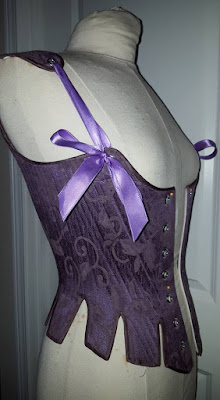Italian Over-Partlet Pattern:
Hello Time Travelers!
Today I'm going to show you how to make alterations to the early Tudor over-partlet by Margo Anderson, into an Italian over-partlet with a Medici style collar.
Here's what you'll need:
- Margo Anderson's Tudor Lady Pattern
- French Curve (see picture below)
- Tracing Paper
- Pencil or ballpoint pin.
- Paper Scissors
You can use this same technique to alter the doublet pattern, but that's another tutorial - as the collar pieces are a bit different than the over-partlet.
Step One:
First of all, you will notice that I leave "all" of the sizes of my patterns intact - in other words, I don't cut out individual sizes. I leave them and trace the size I need. These patterns run about $45 so rather than having to buy a new pattern, or cut and paste them back together, I leave them intact and only cut out around the edges.
Start with your front over-partlet piece.
Lay it on a stable flat surface - not on carpet, or your paper will rip when you try to trace.
If you have a hard time finding your lines, you can color-code your sizes on the original pattern, or just trace YOUR size in red or blue or whatever color you like.
 Part Two:
Part Two: Lay your tracing paper over the pattern. Trace the shoulder, armhole, and the bottom edge.
I use "Swedish" Tracing paper in widths of 29 inches. You can also use the tissue paper used on medical examining tables, but if you don't draft alot of patterns, you may not need that much bulk. It also does not come in widths wider than 21 inches. I prefer a wider paper.

You can purchase "Swedish" Tracing Paper at this website. I have not purchased from them specifically. If you aren't comfortable buying from an un-vetted source, then just go on Ebay and search "Swedish Tracing Paper."

Part Three:
For the collar, use your french curve - the "curved" part, and flare our your collar front as shown in the picture to the right.
 Part Four:
Part Four: Remove the pattern from underneath the tracing paper to reveal your "tracing."
You're not done! You'll want to add a little "flare" to the left side of the collar.
 Part Five:
Part Five: Using your french curve, trace a little triangle as shown in the picture to the right.
Now cut out your traced pattern with your paper scissors. You will need it to help trace your back piece, namely to draft the collar.
Part Six:
Now for the back piece.
You'll want to add a little "flaired" line to the back collar piece, unless you want it to fit snug.
Here's where it might get a little tricky.
Rather than trace your back piece to the exact size you're using, you are going to take your line ALL the way to the top most line or the largest size. See the picture to the left.
The shoulder seam is trace at the proper size. Here I'm using a size 20 just for an example. But I've drawn the line all the way up to the largest size.
Now, you're going to add a little triangle on the right.
 You are only going to add a triangle on the right. NOT on the left, as that is your fold - - you cut the back piece on the fold.
You are only going to add a triangle on the right. NOT on the left, as that is your fold - - you cut the back piece on the fold.So that's it!
You've now altered an early Tudor partlet into a Square Medici Collar, and here's the finished work!

Let me know how it turns out for you!
- Christine.









